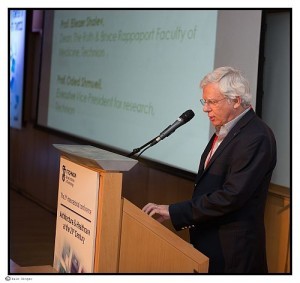When Architecture Meets Medicine
 An International Conference that took place last week at the Faculty of Architecture and Town Planning touched on both fields and overlapping areas between them
An International Conference that took place last week at the Faculty of Architecture and Town Planning touched on both fields and overlapping areas between them
This year, the conference dealt with trends within the medical system in the 21st century, and in “Health Smart Home.” Among conference participants were international lecturers like Tye Farrow from Canada, one of the leading and most influential architects in the design and construction of hospitals; Adam Roberts and Zheng Rong from China, engaged in the recovery and conversion of existing buildings to hospitals; Professor Gianfranco Carrara from Italy, who lectured on his experiences with teaching design and planning of hospitals (a specialized field that is not yet taught in Israel); and George Demiris from the US, a leading researcher in designing smart homes for the elderly. Professor Benjamin Kedar from the Hebrew University in Jerusalem discussed the new discoveries in the area of medicine in Jerusalem dating back to the 12th century.
“Architecture is a serious matter and should not be handed over to architects alone, as is medicine, which is a serious matter that should not be entrusted to doctors alone,” said Professor Yehuda Kalay, Dean of the Faculty of Architecture and Town Planning, at the conference. “We gather here together – doctors, architects and other professionals – to engage in dialogue, collaborate, and look at medicine from different perspectives, and ultimately, to improve the welfare of patients.”
“The health system is facing enormous challenges, and hospitals must be flexible and capable of adjusting to current needs and new technologies,” said Professor Eliezer Shalev, Dean of the Ruth & Bruce Rappaport Faculty of Medicine at Technion. “We are headed towards high tech medicine, medicine that is patient centered and highly concerned with cooperation between clinicians, technicians and planners – the type of cooperation we are advancing in gatherings such as this very conference.”
Canadian architect, Tye Farrow, called for changing the medical debate from that of disease to health. “The medical world is currently working through a pathology-centered agenda and I propose to act through a health-focused agenda. We must understand that our environment is currently working against us, and so we must change it in order to be able to advance our health. When we are planning buildings or expanding public spaces we have to always think about the five essential elements of health – nature, authenticity, variety, vitality and legacy – and continually ask ourselves whether or not the environment we are building promotes health or is working against it.”
Professor Rafael Beyar, the CEO and Director General of the Rambam Health Care Campus and faculty member of the Technion’s Faculty of Medicine, presented the new construction site at Rambam, which includes a children’s hospital and new buildings for treating cancer and cardiovascular diseases. In addition, Professor Beyar described the underground hospital currently under construction in light of the Second Lebanon War. It is a unique structure to be used as a parking lot during routine periods and in emergency situations will be able to be converted into a safe hospital setting within 48 hours (secure from conventional missiles and against biological and chemical warfare).
Conference organizer, Professor Noemi Bitterman from the Faculty of Architecture and Town Planning at the Technion, presented the situation of research on the topic of the Health Smart Home. “Today we emphasize more and more the side of preventive medicine and the quality of life that medicine is supposed to provide us. The greater part of accountability shifts from the hospital wards to the community and the home, and this is why it is important to design homes with focus on quality of life and which can be personalized to suit all of us, including chronically ill patients – a population that is rapidly growing. Proper design in this context will provide all of a dwelling’s residents the independence, quality of life, security and safety they need, which in the long run will reduce the national expenditure on health. Unfortunately, there are still not enough studies examining the effectiveness of such homes, and there are many obstacles such as privacy, security of information as well as different social consequences that must be taken into account. Nevertheless, today there are advanced technologies that enable the transfer of various medical functions – monitoring, early detection, diagnosis, prevention, and treatment–from the hospital to a private dwelling.
The conference, “Architecture and Medicine in the 21st Century,” was organized by the Faculty of Architecture and Town Planning of the Technion and the Ruth and Bruce Rappaport Faculty of Medicine in cooperation with the Ministry of Health, Clalit Health Services, Rambam Health Care Campus, the Municipality of Haifa and other organization. The next conference, which is expected to take place on November 11, 2014, will focus in part on Evidence Based Design, green (sustainable) architecture, and medicine in disaster areas.
Above: Professor Yehuda Kalay, Dean of the Faculty of Architecture and Town Planning. Photographed by Haim Zinger, Technion’s Spokesperson’s Office


